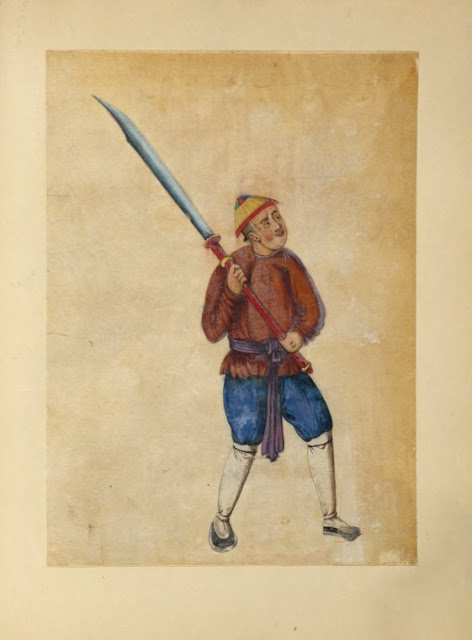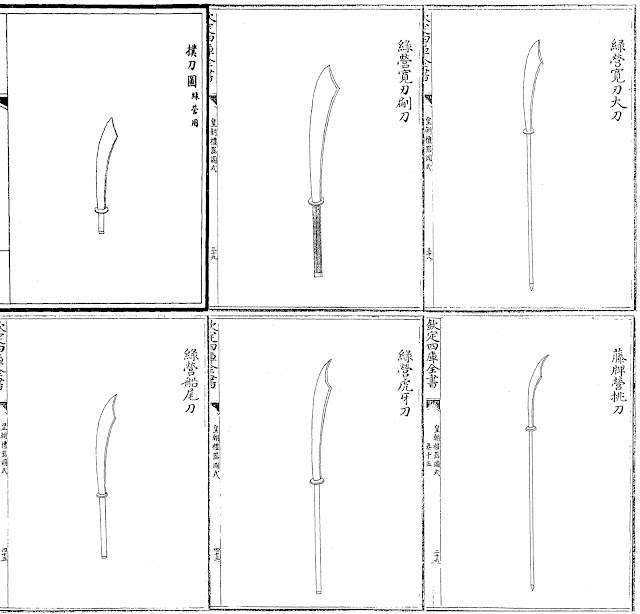 |
| An ornate Po Dao once belonged to Taiping general Luo Da Gang (羅大綱). Private Collection. |
Humble Origin
The weapon known as Po Dao first appeared during Song Dynasty. At the time it was also known as Po Dao (潑刀), Bō Dao (撥刀), Bó Dao (博刀 or 膊刀) and many other names. Essentially a weaponised agricultural tool, Po Dao was not considered a "military grade" regulation weapon and commonly found in the hands of militias, bandits, outlaws and rebels alike (and thus enjoyed unusually high exposure in literature, dramas and plays, which tend to portray civilian rather than military life).Horse Chopper
 |
| A Po Dao (highlighted), also known as Zhan Ma Dao, from 'Wu Bei Yao Lue (《武備要略》)'. |
Although Zhan Ma Dao had become a more recognisable name for Po Dao during Ming period, some Ming texts, such as the writings of general Yu Da You (俞大猷), still referred the weapon with its old name.
Cheng Zi Yi's modified Po Dao
 |
| Cheng Zi Yi's modified Po Dao and scabbard, from 'Wu Bei Yao Lue (《武備要略》)'. |
The new weapon features ridged cross-section and resembles both a Dan Dao (單刀) and a Song period Zhan Ma Dao.
Qing Dynasty Po Dao
After the fall of Ming, many elements of former Ming military were absorbed into Qing military system and reorganised into either Lu Ying (綠營, Green Standard Army) or Han Jun (漢軍, lit. 'Han army', ethnic Han bannermen). These Han Chinese soldiers retained most of their traditional weapons and equipment, only minimally modified to adapt to the new military regulation.
Under Qing military regulation, Po Dao was divided into several subtypes based on their length and blade profile:
- Lu Ying Pu Dao (綠營撲刀, lit. 'Green Standard Army Pu Dao') is a rather short, one-handed version of Po Dao.
- Lu Ying Kuan Ren Pian Dao (綠營寬刃㓲刀, lit. 'Green Standard Army broad bladed slicing sabre') is a Po Dao with a handle of about equal length to its blade.
- Lu Ying Kuan Ren Da Dao (綠營寬刃大刀, lit. 'Green Standard Army broad bladed great glaive') is a standard polearm-length Po Dao.
- Lu Ying Chuan Wei Dao (綠營船尾刀, lit. 'Green Standard Army stern sabre') is named due to the blade shape's similarity to the stern of a ship. It is a two-handed sword that has a longer and sharpened clip point tip for better thrusting capability.
- Lu Ying Hu Ya Dao (綠營虎牙刀, lit. 'Green Standard Army tiger tooth sabre') is a larger version of Chuan Wei Dao that has a roughly equal ratio of handle length to blade length.
- Teng Pai Ying Tiao Dao (藤牌營挑刀, lit. 'Rattan Shield Regiment lifting glaive') is a polearm-length version of Chuan Wei Dao with narrower blade. Unlike other weapons in this list, this weapon was issued to Han Bannermen that specialised in rattan shield tactics.
Late Qing period Shuang Shou Dai (雙手帶) and Tai Ping Dao (太平刀)
 |
| Mid-nineteenth century export painting depicting a militiaman armed with a Shuang Shou Dai. From Digital Collections of the New York Public Library. (Source: Kung Fu Tea) |
As the once great Qing Empire aged and corruption began to run rampant, its hereditary military system also weakened and eventually collapsed. Militias and levies replaced professional soldiers as the main source of recruit, and brought with them many non-regulation weapons. Po Dao, which has its root in agricultural tool and civilian weapon, once again became one of the most common close combat weapons of the Qing army.
Late Qing period Po Dao are generally short polearms with roughly equal length handle and blade. As old regulations and names fall into disuse, these short polearms came to be known as Shuang Shou Dai (雙手帶, lit. 'Double hand carry'), even though the term originally referred to a type of two-handed sabre. After Taiping Rebellion broke out, this weapon gained yet another moniker "Tai Ping Dao (太平刀, lit. 'Taiping sabre')" due to its prevalence among Taiping rebels.
Republican Long handled Da Dao (大刀)
 |
| Chinese soldiers during the Second Sino-Japanese War, armed with Shuang Shou Dai-type Da Dao. |

http://chineseswords2.freewebspace.com/images/kangxiqqpww.jpg
ReplyDeleteCould this sword be considered as zhanmadao or pudao?
P.s i wanna know name of the sword
This weapon is one of a kind, so it doesn't have a proper name. It is commonly called "(Emperor) Kangxi's war sabre" after its original owner.
DeleteIts hilt shows clear SE Asia dha influence. It is also very short (89 cm) and is very possibly a one-handed sword.
Modern reproductions sometime make the weapon longer and market it as zhanmadao though.
https://baike.baidu.com/pic/%E6%9C%B4%E5%88%80/6501194/0/d833c895d143ad4bfcf8cf3481025aafa50f066b#aid=0&pic=d833c895d143ad4bfcf8cf3481025aafa50f066b
ReplyDeleteDo you have any information about this artifact?
That one is probably a Song Dynasty Zhanmadao, although without ring-pommel. I suppose it is in private hands.
Deletewhy this sword suddenly became popular during taiping rebellion era?
ReplyDeleteIt was always quite popular. I think the reason is that Taipin rebels had a higher porportion of cold weaponry compared to the firearm-equipped Qing army, thus giving a deeper impression of using Podao.
Deletei thought before that in ming and song era polearm version was dominant than sword type
DeleteTaiping rebels also used the polearm/half-polearm version.
Deletewhat's Cheng Zi Yi said about modified pudao in his book? (and if it doesn't bother you could you introduce his opinion about his version of wolf tooth cudgel?)
ReplyDeleteHe said older Po Dao are either too thick and cumbersome, or don't have spined blade (ridged cross-section like Japanese sword) and thus are "soft", so he modified his Po Dao with ridged cross-section blade.
DeleteHe said his modified wolf-tooth cudgel is easier to use on horseback.
Beautiful ❤️.... thank you
Delete